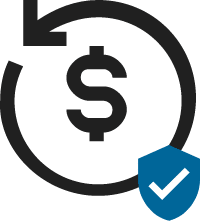Did you pay with a credit card or debit card? Bank wire? Cryptocurrency?
Let’s get your money back!
If you are unfamiliar with the term, your first question is probably going to be "What is a credit card chargeback?" or "What are chargebacks?" or "What does 'chargeback' mean?" Even if you know, you still might ask "How do chargebacks work?" or "Is there a credit card chargeback time limit?" or "How to file a chargeback?"
Every time you use a credit card or debit card you are initiating a transaction that is controlled and regulated. If it’s a Visa or Mastercard, your transactions are governed by terms and conditions that they adopted and published. These terms and conditions define rights and obligations for you, your bank, the merchant, and its bank.
For example, if your card was lost or stolen and you see unexplained transactions on your account, you can immediately request your bank to reverse the charges. Visa and Mastercard mandate your bank take that action to protect you from fraud. Even when you willingly make a purchase, you are protected should your purchase not materialize or you receive something other than what was promised.

A chargeback is a cancellation of a transaction. The charge is reversed and goes back to your credit card. You can request a chargeback from the bank that issued the card If:
Visa and Mastercard guarantee that you can apply for a chargeback at any time within 120 days from the date of the transaction. Under certain conditions, the chargeback processing period can be as many as 540 days. In some jurisdictions, the law provides you with even more time to apply for a chargeback.
American Express also imposes a 120-day time limit on its cardholders. Discover and Diners Club International, which it owns, do not have any chargeback time limit.
The debit card or credit card chargeback process begins when a cardholder submits a request to dispute a transaction with the merchant to the bank that issued the card or the issuing bank.
Once the issuing bank accepts your request, it will raise a dispute with the merchant’s bank or the acquiring bank. The issuing bank alerts the acquiring bank through the credit card network’s dispute resolution center scheme. The acquiring bank then informs the merchant.
In certain cases, the sum you challenge may at this time re-appear in your account as a temporary credit. If so, DO NOT use it. Wait until you win your case and the temporary credit becomes permanent.
At the end of the process, the issuing bank will either side with the merchant, and say the transaction stands or will require the merchant to return the money to the customer.
The decisive factor in the chargeback process is persuading the issuing bank that the customer deserves to have their money returned. The key is providing supporting evidence and documentation to bolster the claim.
Enter MyChargeBack. Our team collects information, investigates fraudulent merchants and brokers, and will give you a game plan to make your chargeback claim successful.


The Global Leader in Resolving Complex Card-not-Present Transactions
Did you pay with a credit card or debit card? Bank wire? Cryptocurrency?
Cactil is registered with the Information Commissioner’s Office in Respect of the Data Protection Act 2018, Number: ZA664835. The office address of Cactil LLC is 1441 Broadway, 3rd Floor, PMB #3111, New York, NY 10018.
MyChargeBack regards phishing and spoofing attempts against our clients very seriously. We advise you to verify that the email you receive from MyChargeBack is indeed sent from mychargeback.com. If you are sent any type of communication carrying our name that looks suspicious, please forward a copy to us at [email protected]